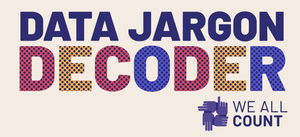Featured Resource: Data Equity Framework and We All Count tools
By Dr. Jonathan A. Caballero, Implementation Support Consultant
5-min read
Evidence-based decision-making and equity are two key topics at The Center for Implementation. Often, we suggest reflecting on what people are considering “evidence” and critically reflecting on who has produced it, whose reality it reflects, and whether there are evidence gaps in data sources themselves that may inadvertently distort reality or create inequities (for example, in the recently launched StrategEase course).
As these types of reflections are not necessarily common practice across disciplines and contexts, going through them might seem daunting. After all, if you and your team are not already doing it, it’s likely that you’ll encounter barriers and facilitators to start pausing to critically reflect on what “evidence” means in your context.
In other words, changing how we think about the relationship between evidence and equity and the way that we draw inferences from the evidence to inform our practice can be considered, in and by itself, an implementation project.
The Data Equity Framework and the Tools developed by We All Count can help you go through this process.
The Framework
The Data Equity Framework is “a systematic way of looking at data projects.” It presents logical steps that data projects tend to go through regardless of the context where they are developed (be it a non-profit organization producing a white paper or a medical association developing a health-centered app, for example).
It makes explicit common (but not always obvious) ways in which inequities could inadvertently occur in each of the steps: Funding, Motivation, Project Design, Data Collection & Sourcing, Analysis, Interpretation, and Communication & Distribution.
A core idea for all steps is that, because of the very nature of working in a data-centered project, teams must make a plethora of decisions, which, if left unchecked, can introduce inequities along the process. The Data Equity Framework encourages teams to clearly and specifically define what they mean by equity and to use these definitions (along with tools, checklists, and practices) to guide their decisions purposefully.
The Toolkit
To support people working to improve equity in their data projects, they offer a set of practical tools. A cool thing about them from an implementation viewpoint is that they can support teams in addressing diverse barriers that might be present in their context. We briefly present 3 tools here, but we invite you to explore them by yourself!
If not everyone on your team is familiar with vocabulary specialized in analyzing and interpreting data, you might want to try the Data Jargoon Decoder.
Sometimes the core team working on a data-centered project are well-versed in the minutiae of working with data but would like to get buy-in from leadership about approaches to strengthen equity in their processes. If that’s your situation, the Talk to Your Boss Sheets may be for you!
Probably, you are interested in understanding better the key relationships between key groups involved in your data project. Who is providing funding to whom? Where data comes from? Which groups influence (or are influenced by) which other groups? Understanding these types of relationships can quickly become challenging but mapping them using a visual representation is super handy. You can do so with the Funding Web Builder!
Additional resources that can help you address other types of barriers and facilitators, such as training (for addressing skill gaps) or a forum (which can be a way of leveraging social influences), are available on their webpage (and, as always, if you are not sure about which change strategies could better suit your initiative, the StrategEase tool can help you with it).
Now go ahead and explore some of these practical tools to weave equity in the way you approach data and evidence to guide your decision-making.
This article was featured in our monthly Implementation in Action bulletin! Want to receive our next issue? Subscribe here.




